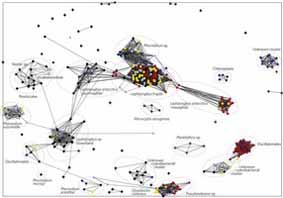
Global warming will produce modifications in the biological communities of polar regions. These would entail a change in the dominant species and the relations among them. This is what a study published in the journal ‘Nature Climate Change’ conducted by the lecturers Antonio Camacho at Universitat de València’s Instituto Cavanilles (Parc Científic) and Antonio Quesada at Universidad Autónoma de Madrid states. The study has been done thanks to an international research project.
Climatic change, and the warming which is having place in Antarctica and the Arctic, will bring important changes in the cyanobacteria mats, which are the most important biological communities in the polar zones, since they cover large ice-free zones during the polar summer, thus modifying substantially the biogeochemical cycles in those zones. The changes will entail changes in the dominant species and the relations among them, an increase in toxin-producing species, and an increase in the exchanges of carbon and nitrogen among living and inert beings. This is what a study just published in the journal Nature Climate Change states. It has been conducted by the lecturers Antonio Camacho at Universitat de València’s Instituto Cavanilles (Parc Científic) and Antonio Quesada at Universidad Autónoma de Madrid, and it has been done thanks to an international research project.
The experiments were carried out with microbacteria mats, microbial communities multi-layered dominated by cyanobacteria, which were obtained from Byers Peninsula (Livingston Isle, in the South Shetland Islands Archipielago, Antarctica). This was possible thanks to the former Ministry for Science and Innovation’ s funding during the International Polar Year, and other Arctic regions’ funding. The mats were preserved at different temperatures during six months. These temperatures were similar to those found in Antarctica and the Arctic, and they represented the temperatures that could be reached after several decades, according to the climatic change models. The results, supported by molecular and microscopic analysis, show a remarkable change in the species dominating the mats. At the same temperatures in the región, there would be an increase in the cyanobacteria diversity. It would also be anther change: the dominant species in low temperatures would disappear.
At higher temperatures the tendency is inverted, diversity decreases and the mats tend to destabilize. If they would disappear so would be with the biological communities, microbial in this case. This modifications in the species might have important effects on the rest of organisms in these microsystems: virus, bacteria, protozoos, etc. whose food is cyanobacteria. These organisms usually eat this food, but what is more important is that the modifications could affect the global working of these polar ecosystems, specially in these zones in the planet suffering the heaviest warming. One of the most shocking results in the study is that cyanobacteria dominating the macrobial mats beggin to produce toxins – especially, microcystins – at the expected temperatures in the region due to climatic change. These microcystins could have a great influence ein the remaining organisms.
Those toxins are well known in temperate regions. However, they are scarce in the polar ecosystems, and it is the first time they appear in the Arctic as this study has shown. Their effects could be letal on several organisms.
Julia Kleinteich, Susanna A. Wood, Frithjof C. Küpper, Antonio Camacho, Antonio Quesada, Tancred Frickey and Daniel R. Dietrich. (2012) Nature Climate Change. DOI 10.1038/NCLIMATE1418
http://www.nature.com/nclimate/journal/vaop/ncurrent/full/nclimate1418.html
Last update: 29 de may de 2012 08:33.
News release



















